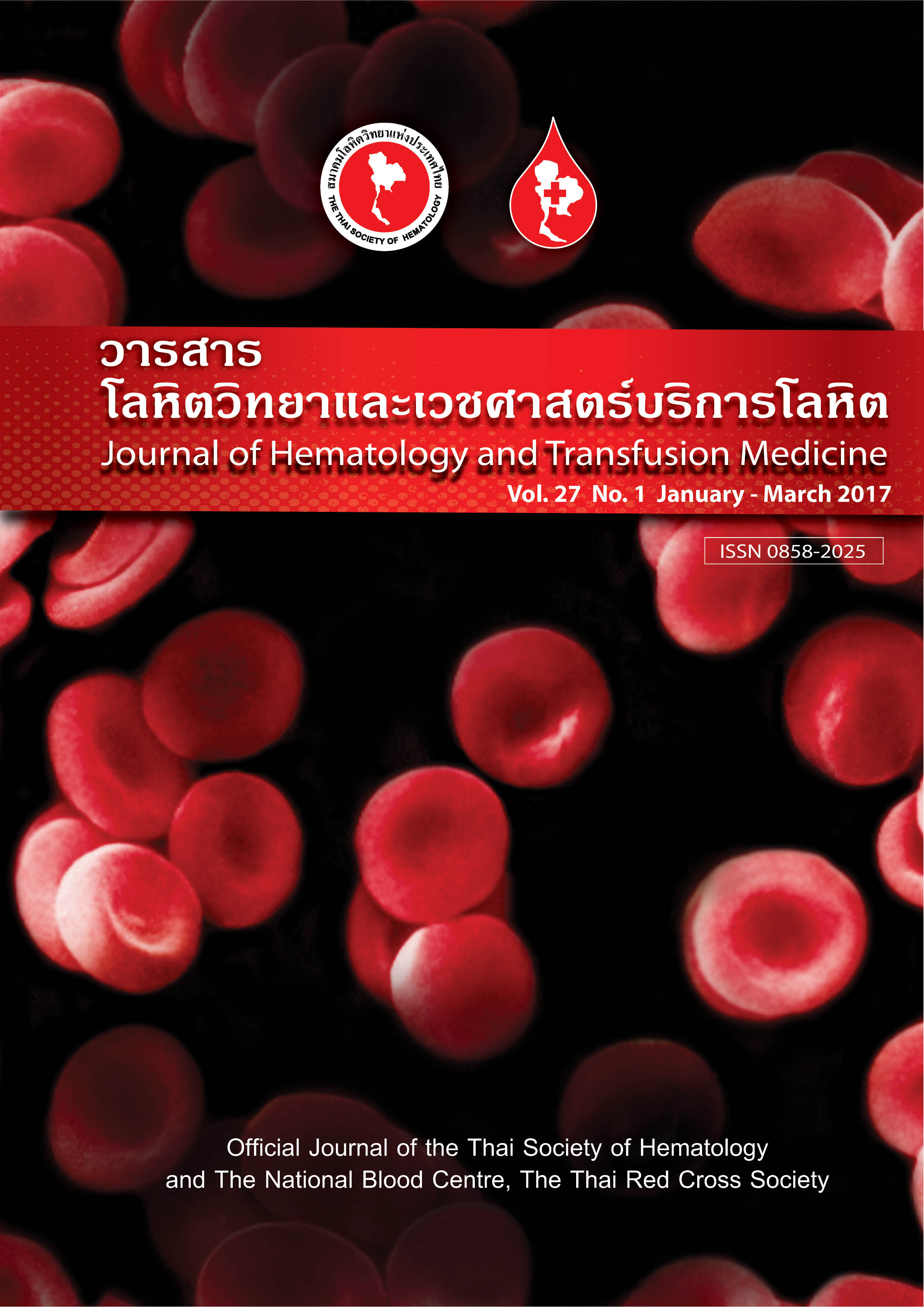The validity of various prognostic models for predicting the outcome in peripheral T-cell lymphoma
Keywords:
Peripheral T-cell lymphoma, Prognostic models, Validity, OutcomeAbstract
บทนำ โรคมะเร็งต่อมน้ำเหลืองชนิด peripheral T-cell lymphoma (PTCL) ประกอบด้วยกลุ่มย่อยที่หลากหลายและผลการรักษาแตกต่างกันในแต่ละชนิด โรค PTCL มีความชุกในแถบกลุ่มประเทศเอเชียมากกว่าในกลุ่มประเทศตะวันตก ได้มีการใช้แบบจำลองการพยากรณ์โรคได้แก่ International Prognostic Index (IPI), Prognostic Index for T-Cell lymphoma (PIT) และ International Peripheral T-Cell Lymphoma Project score (IPTCLP) เพื่อทำนายผลการรักษาในผู้ป่วย PTCL การศึกษานี้มีวัตถุประสงค์เพื่อประเมินความตรงของแบบจำลองการพยากรณ์โรคทั้ง 3 แบบดังกล่าว และศึกษาปัจจัยที่มีผลต่อการตอบสนองต่อการรักษา และอัตราการรอดชีวิตในผู้ป่วยมะเร็งต่อมน้ำเหลืองชนิด PTCLในโรงพยาบาลสงขลานครินทร์
วัสดุและวิธีการ ศึกษาข้อมูลย้อนหลังของผู้ป่วยที่มีอายุ 15 ปีขึ้นไปและได้รับการวินิจฉัยว่าเป็นมะเร็งต่อมน้ำเหลืองชนิด PTCL ตาม WHO classification 2008 ในรพ.สงขลานครินทร์ ตั้งแต่เดือนมกราคม 2544 –ธันวาคม 2557 ผู้ป่วยทุกรายได้รับการคำนวณคะแนนของแบบจำลองการพยากรณ์โรคทั้ง 3 แบบ คือ IPI, PIT และ IPTCLP เพื่อเปรียบเทียบอัตราการตอบสนองสมบูรณ์ (complete response) และการรอดชีวิตโดยรวม (overall survival) ของผู้ป่วยแต่ละกลุ่มความเสี่ยง ผลการศึกษา ผู้ป่วยจำนวน 182 ราย (ผู้ชาย 128 ราย ผู้หญิง 54 ราย) มัธยฐานของอายุ 53 ปี (พิสัย 15-89 ปี) แบบจำลองการพยากรณ์โรคทั้ง 3 แบบ สามารถทำนายผลการรักษาและอัตราการรอดชีวิตโดยรวมในผู้ป่วยโรค PTCL ได้อย่างมีนัยสำคัญ โดยที่ผู้ป่วยที่อยู่ในกลุ่มความเสี่ยงต่ำ (low risk) จะมีอัตราการตอบสนองต่อการรักษาและอัตราการรอดชีวิตโดยรวมดีกว่ากลุ่มความเสี่ยงสูง (high risk) แบบจำลองการพยากรณ์โรค IPICPL สามารถจำแนกการพยากรณ์โรคได้ดีกว่าอีกสองแบบ ปัจจัยที่สัมพันธ์กับระยะเวลาการรอดชีวิตของผู้ป่วยที่พบในการศึกษานี้ ได้แก่ สภาพของผู้ป่วยตามคะแนน Eastern Cooperative Oncology Group (ECOG) ที่สูง จำนวนเกล็ดเลือดที่น้อยกว่า 150,000 ตัว/ลบ.มม. และการมีรอยโรคในไขกระดูก สรุปผล แบบจำลองการพยากรณ์โรคทั้ง 3 แบบ สามารถทำนายการตอบสนองต่อการรักษาและอัตราการรอดชีวิตโดยรวมของผู้ป่วยโรค PTCL แต่ละกลุ่มได้อย่างมีนัยสำคัญ โดยที่ IPTCLP เป็นแบบจำลองการพยากรณ์โรคที่ดีกว่าแบบ IPI และ PIT อย่างไรก็ตาม ควรมีการสร้างแบบจำลองการพยากรณ์โรคโดยใช้ข้อมูลปัจจัยการพยากรณ์โรคจากผู้ป่วยในการศึกษาครั้งนี้ต่อไป
Background: Peripheral T-Cell lymphomas (PTCLs) are a heterogeneous group of lymphomas with different outcomes and are more prevalent in Asian than in Western countries. International Prognostic Index (IPI), Prognostic Index for T-Cell lymphoma (PIT) and International Peripheral T-Cell Lymphoma Project score (IPTCLP) were proposed to predict clinical outcome for PTCLs. The objectives of this study were to validate these three models and identify the prognostic factor associated with overall survival of Thai patients with PTCLs in Songklanagarind Hospital. Materials and methods: The retrospective study of adult patients with age >15 years old and with a diagnosis with PTCLs according to WHO classification 2008 in Songklanagarind Hospital from January 2001 - December 2014 was performed. Prognostic scores regarding IPI, PIT and IPTCLP were calculated. Complete response (CR) rate and overall survival (OS) were analyzed using different prognostic models. Result: In all, 182 patients were recruited (128 males, 54 females). Median age was 53 years (range 15-89 years). IPI, PIT and IPTCLP could significantly predict both CR rate and OS in patients with PTCLs. CR rate, as well as OS, in the lower risk group was better than in the higher risk group. IPTCLP provided more discrimination among prognostic groups than the other two models. Independent prognostic predictors associated with shorter survival in this study included poor ECOG score, platelets <150,000/L and bone marrow involvement. Conclusion: All three prognostic models demonstrated predictive significance on CR rate and OS of our patients with PTCLs, And IPTCLP presented the best model. Further, a new model will be proposed based on independent prognostic factors derived from our patients.



